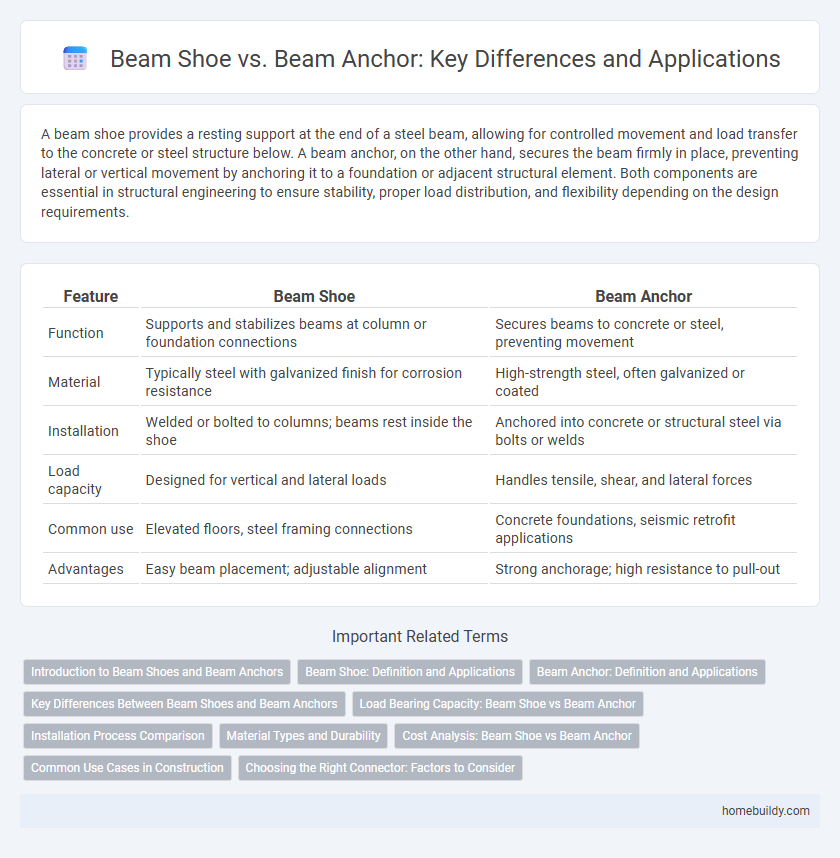A beam shoe provides a resting support at the end of a steel beam, allowing for controlled movement and load transfer to the concrete or steel structure below. A beam anchor, on the other hand, secures the beam firmly in place, preventing lateral or vertical movement by anchoring it to a foundation or adjacent structural element. Both components are essential in structural engineering to ensure stability, proper load distribution, and flexibility depending on the design requirements.
Table of Comparison
| Feature | Beam Shoe | Beam Anchor |
|---|---|---|
| Function | Supports and stabilizes beams at column or foundation connections | Secures beams to concrete or steel, preventing movement |
| Material | Typically steel with galvanized finish for corrosion resistance | High-strength steel, often galvanized or coated |
| Installation | Welded or bolted to columns; beams rest inside the shoe | Anchored into concrete or structural steel via bolts or welds |
| Load capacity | Designed for vertical and lateral loads | Handles tensile, shear, and lateral forces |
| Common use | Elevated floors, steel framing connections | Concrete foundations, seismic retrofit applications |
| Advantages | Easy beam placement; adjustable alignment | Strong anchorage; high resistance to pull-out |
Introduction to Beam Shoes and Beam Anchors
Beam shoes and beam anchors serve crucial roles in structural engineering by securing beams to columns or foundations. Beam shoes provide a seated support that distributes loads evenly and allow slight movements, reducing stress on connections. Beam anchors, on the other hand, rigidly fix beams in place, ensuring stability and preventing displacement under heavy loads or dynamic forces.
Beam Shoe: Definition and Applications
A beam shoe is a structural steel connection device used to support and anchor beams to columns or walls, allowing for controlled movement and load transfer. Commonly utilized in construction projects, beam shoes provide stability while accommodating thermal expansion and contraction or seismic activity. Their applications span commercial buildings, bridges, and industrial frameworks where secure yet flexible beam connections are essential.
Beam Anchor: Definition and Applications
Beam anchors are specialized hardware components designed to securely attach beams to structural elements such as concrete or masonry walls. They provide critical load transfer and stability by anchoring the beam firmly, preventing lateral and vertical movement under various stress conditions. Commonly used in construction and engineering projects, beam anchors ensure structural integrity in frameworks subject to dynamic or heavy loads.
Key Differences Between Beam Shoes and Beam Anchors
Beam shoes provide lateral support by securing the beam to columns or posts, typically using bolts or screws, ensuring stability against horizontal forces. Beam anchors, on the other hand, are designed to fix beams directly into concrete or masonry foundations, offering vertical load transfer and resistance against uplift forces. The key difference lies in their function and installation: beam shoes connect beams to structural supports for side stability, while beam anchors secure beams to concrete bases for foundational anchorage.
Load Bearing Capacity: Beam Shoe vs Beam Anchor
Beam shoes offer superior load bearing capacity by providing a full bearing surface that evenly distributes weight across the beam, enhancing structural stability. Beam anchors, while effective for securing beams to concrete or masonry, generally have lower load bearing capacity as they rely on mechanical fastening rather than full surface support. Choosing between a beam shoe and beam anchor depends on the required load capacity and connection type for the specific structural application.
Installation Process Comparison
Beam shoes offer a straightforward installation process, typically fastened directly to concrete or masonry surfaces using anchors or bolts, making them suitable for quick setups. Beam anchors require precise drilling and embedding into concrete, demanding more time and specialized tools to ensure secure placement and load transfer. The choice between beam shoes and beam anchors depends on project complexity, with beam shoes favored for ease, while beam anchors provide enhanced stability in structural applications.
Material Types and Durability
Beam shoes are typically made from galvanized steel, offering excellent corrosion resistance and durability for supporting beams in concrete structures. Beam anchors, often constructed from stainless steel or heavy-duty carbon steel, provide superior strength and long-term stability by anchoring beams securely into foundations. Material choice directly impacts durability, with galvanized steel being cost-effective for general use and stainless steel preferred for harsh or corrosive environments.
Cost Analysis: Beam Shoe vs Beam Anchor
Beam shoes typically offer a lower initial cost compared to beam anchors, making them a cost-effective option for projects with budget constraints. Beam anchors, while generally more expensive upfront, provide enhanced stability and load-bearing capacity, potentially reducing long-term maintenance and replacement costs. Analyzing total lifecycle expenses reveals that beam anchors may offer better value in infrastructures requiring high durability and safety standards.
Common Use Cases in Construction
Beam shoes are typically used to provide a secure bearing surface for steel beams resting on concrete or masonry supports, ensuring load distribution and stability in structural framing. Beam anchors serve to fasten beams directly to concrete or masonry, offering enhanced lateral support and preventing movement in seismic or high-wind conditions. Common construction applications for beam shoes include residential and commercial floor framing, while beam anchors are often employed in retaining walls, bridges, and heavy-duty structural connections.
Choosing the Right Connector: Factors to Consider
Selecting the appropriate beam connector involves evaluating the load capacity, installation environment, and structural requirements. Beam shoes provide robust support for cantilevered or perpendicular beams by anchoring directly to concrete or steel surfaces, ideal for heavy load applications. Beam anchors offer flexibility in positioning and are preferred for applications requiring adjustability and minimal drilling, making them suitable for retrofit projects or complex framing systems.
Beam shoe vs Beam anchor Infographic

 homebuildy.com
homebuildy.com